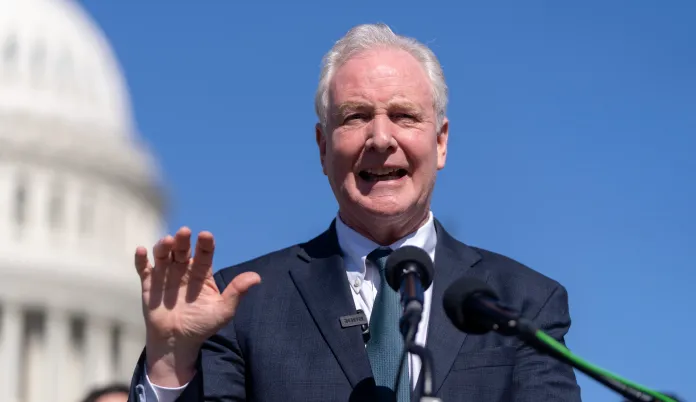Federal Workers Are Being Held Accountable For The First Time
The article discusses the controversy surrounding the trump governance’s efforts to downsize the federal bureaucracy, notably in the Washington, D.C. area. While many federal employees and local residents express concern over job losses, the author points out that federal employees in D.C. tend to be well-paid and protected from termination, with very few fired for poor performance. The article highlights the recent layoffs at the State Department, which had significantly expanded over the years, and notes public support for reducing what some see as an overgrown and ineffective bureaucracy.
The piece also reviews Michael Lewis’s book *Who Is Government?: The Untold Story of Public Service*, which aims to recognize exemplary federal workers through a collection of essays. While the author acknowledges the value in showcasing outstanding public servants, he criticizes the book for failing to address widespread issues of poor performance and corruption within the federal workforce. He recounts personal experiences with challenging federal employees and mentions recent federal scandals to illustrate systemic problems.
Moreover,the article criticizes the Department of Education as an example of ineffective federal spending,pointing to poor student outcomes despite record-high per-pupil expenditures. The author supports Trump’s plan to dismantle the Department of Education and redirect funds to states, arguing that accountability is necessary alongside recognition.
the article encourages readers to appreciate good federal workers but insists that reform and accountability are essential for a bureaucracy that truly serves the public.
Right now, there’s a lot of angst in certain corners about the Trump administration’s attempt to downsize the federal bureaucracy. I say “certain corners” because I don’t think this concern is widely held by American voters, but since I live in a Washington, D.C. suburb there’s a lot of anguished Facebook posts and fretful conversations between neighbors — to say nothing of a sudden increase in housing stock, following years of high mortgage rates suppressing the market.
On one hand, it’s hard to see anyone lose their job, let alone your neighbors. On the other hand, the D.C. area is one of the wealthiest areas in the country because at the bottom of a pyramid of absurdly well-compensated lawyers, lobbyists, and government contractors are about 400,000 federal employees. The average federal employee working in D.C. earns $120,305 in salary alone, not factoring in the federal government’s absurdly generous benefits.
Making things worse, a lot of the D.C. drama is federal workers realizing for perhaps the first time they are not impervious to being fired. Some years ago, a very fetching young woman had a full-time job reporting on the federal workforce. Among her findings: “Eight cabinet-level departments — employing about 486,000 people — did not fire a single employee for poor performance between 1998 and 2003.” Granted, Mrs. Hemingway wrote that story quite a while ago, so I checked to see if things are getting better. According to the Office of Personnel Management’s website, out of 2,313,216 federal employees, last year just 5,988 employees were terminated for discipline or performance reasons, roughly one quarter of one percent. Once you get a federal job, it’s more or less impossible to lose it.
Or at least it was, until Trump’s second term. Last week, the State Department laid off 1,300 employees. Naturally, the firing confirmed the worst suspicions of everyone that wants federal bureaucrats fired. It turns out the State Department was in fact filled with the worst sort of left-wing activist drama queens who issued vague threats against the democratically elected government that fired them on their way out the door.
And if you could possibly feel less sympathy for these fired State Department workers, know that the State Department “went from 57,340 total employees in 2007 to 72,895 in 2015 to 80,214 in 2024. So it grew by nearly 23,000 employees before the ‘devastating’ cut of 1,300.” I’d say “don’t let the door hit you on the way out,” but judging by the online reaction, lots of Americans see this behavior and aren’t just hoping the door hits these entitled bureaucrats, they’re rooting for injuries.
It’s pretty hard to defend the federal bureaucracy’s status quo, and yet, there are people trying. Earlier this year, superstar journalist Michael Lewis — the guy behind Moneyball, The Blind Side, and The Big Short — published Who Is Government?: The Untold Story of Public Service. Edited by Lewis, it’s a collection of essays from him and other big selling authors including Dave Eggers, Sarah Vowell, and Geraldine Brooks, all touting fine examples of public service.
I was prepared to roll my eyes through the whole thing, but I’m happy to report that in many ways the book is both more interesting and better intentioned than I expected. Early in Lewis’ own essay in the book he discusses the Partnership for Public Service, an organization that, among other things, hands out awards to civil servants that do extraordinary things. “There’s no culture of recognition in government,” said Max Stier, who runs the Partnership. “We wanted to create a culture of recognition.” It’s true that there is often no good recognition of federal workers that do extraordinary things for the taxpayer, and this book tells the story of some remarkable people.
Lewis’ essay ultimately tells the story of the son of an Ivy League professor who becomes a left-wing labor agitator, which leads him to working alongside coal miners in West Virginia. His experience with the unsafe conditions in mines sends him to engineering school, and afterward he ends up at the Bureau of Mines, where he does pioneering and lifesaving work on preventing the roofs of mines from collapsing. Another chapter is on the head of the National Cemetery Administration, who has done extraordinary work handling the bodies of dead American servicemen, even going so far as to newly identify and properly bury remains dating back to World War II. Dave Eggers reports on the groundbreaking science work being done at the famed Jet Propulsion Laboratory, and so on. It’s genuinely interesting and inspiring stuff, and the public should know about these workers.
But in other ways, the book is exactly as myopic and out-of-touch as you might expect. The introduction to the book is a predictable “But Trump!” where Lewis admits he’s doing the book because the “the PR wing of the federal government isn’t really allowed to play offense.” (The political agenda of the book is surely why it’s one of Amazon’s “Best Books of the Year” because, while interesting, it’s not that special.) In the penultimate paragraph of the introduction, he even acknowledges that one reason why people don’t care more about federal employees is “in our heads this intractable picture: The nine-to-fiver living off the taxpayer who adds no value and has no energy and somehow still subverts the public will.” But then he says nothing more about why this portrayal of federal workers might loom so large.
Well, having been a political reporter in D.C. for 26 years, the fact there are extraordinary federal workers is unsurprising to me. I personally know good, talented people in the trenches. What is likely surprising to Lewis’ affluent center-left readers is that the bad federal workers are so, so much worse than unmotivated nine-to-fivers.
I once had the number two guy at a major cabinet agency tell me over beers about how they had an employee at the agency library who would literally spit on people who asked them to do things they did not want to do. This person had been doing this for some time, and there were already multiple people who had filed complaints. However, this wasn’t deemed to be enough complaints, so some employees at the agency took one for the team and went to the library to report back about being spat upon and to generate new complaints. It took months and reams of paperwork to fire this person; the whole saga was like something out of Brazil for an offense so basic that it would get you fired on the spot in the private sector. Anyway, if anyone is writing a collection of middlebrow essays on problematic federal workers, give me a call! I’ve got a story for you.
That story, as off-putting as it might be, isn’t that malevolent compared to the run-of-the-mill abuses. The number of times federal workers get indicted for corruption or political crimes is fairly startling, and enough to make you wonder about how many unindicted federal workers are getting away with it. There were two press releases just yesterday — one about federal law enforcement charged in a visa fraud scheme, and another relating to a federal worker physically threatening a Republican congressman. Contra Lewis, the federal workforce has much bigger problems than inadequate PR.
In any event, Who Is Government? is a bad PR campaign for no other reason than it’s a book at a time when comparatively few people read anymore. Why is that? Well, let’s take a look at the Department of Education:
Are these the kinds of charts you’d expect if the federal Department of Education actually improved student outcomes? pic.twitter.com/8WIy84H2Zy
— stevemur (@stevemur) July 15, 2025
Currently, 69 percent of American K-12 students are not reading at grade level. And this is happening at a time when extraordinary amounts of money are being spent on education. Thanks in part to federal largesse, average educational spending in America tops $20,000 per kid for these dismal results. Ironically, Washington, D.C. is one of the worst school districts in the country and spends the most per pupil — a whopping $31,629. In the 46 years since the creation of the Department of Education, student performance has gotten worse by nearly every metric, while centralizing control over education has expanded power for teacher unions and rapidly increased spending.
It’s great that there are individuals doing extraordinary work in the federal workforce, and it’s good to recognize them. But when there’s an entire cabinet agency with a budget of $268 billion that’s actively destroying the future of America’s kids, well, I would venture that needs to be acknowledged, and in this case, Trump’s plan to shutter the agency, eliminate the bureaucracy, and funnel the money directly to the states is a good one.
So I would encourage you to read Who Is Government? and do it with an open mind. Let’s build a “culture of recognition” that rewards good federal employees, and better educates the public on the good things our federal agencies are doing for us. I would just humbly suggest that a culture of recognition is worthless without also building a strong culture of accountability. Based on the petulant reaction and baseless legal resistance to an elected president’s fairly modest attempts at reforming and downsizing an unelected bureaucracy, we have a long way to go before we get bureaucracy that puts the citizens’ needs before its own.
Mark Hemingway is the Book Editor at The Federalist, and was formerly a senior writer at The Weekly Standard. Follow him on Twitter at @heminator
" Conservative News Daily does not always share or support the views and opinions expressed here; they are just those of the writer."




